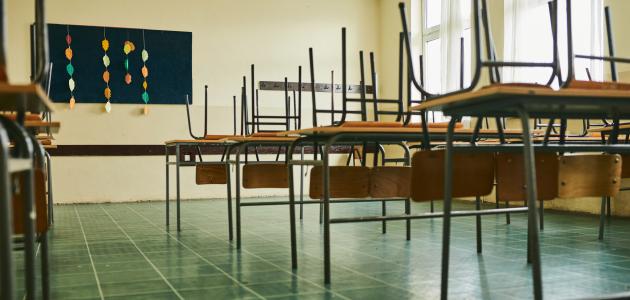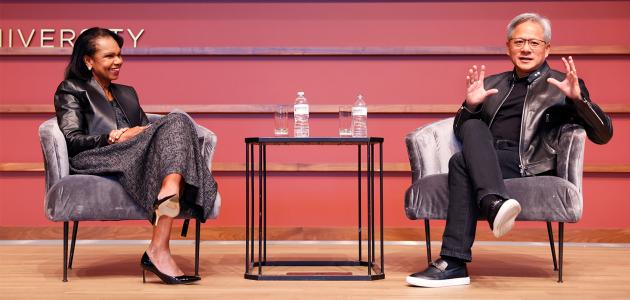The Hoover Institution commemorated National School Choice Week with conversations led by Director Condoleezza Rice on how school choice programs have increased educational achievement among young Americans, especially those less fortunate in society.
A School Choice Revolution in Indiana
The program began with a keynote discussion between Rice and Mitch Daniels, who as governor of Indiana and later president of Purdue University exhibited visionary leadership in achieving educational reform in the Hoosier State.
Daniels said that in the first six years of his administration as Indiana governor, he and his colleagues were only able to achieve reforms on a piecemeal basis. A breakthrough occurred midway through his second term, when during the 2010 elections, Republicans realized substantial gains in the state legislature and made school choice one of their core issues.
“At that point, we ran the table on education reform,” said Daniels.
In May 2011, Daniels penned his signature on what was called “the nation’s most ambitious voucher program,” which over the decade since its passage has provided scholarships to hundreds of thousands of students worth up to 90 percent of per-pupil funding in traditional public schools.
He also signed a measure that enabled the expansion of charter school networks.
Daniels stressed that the school choice revolution in Indiana wasn’t achieved without considerable opposition from forces of the status quo—most notably well-funded and powerful teachers’ unions.
Daniels explained that his office launched an advocacy campaign to counter false assertions about his administration’s school choice initiatives. Such charges included that the proposed reforms were anti-teacher and would reduce per-pupil funding in traditional public schools. On that latter point, Daniels maintained that in most jurisdictions where school choice programs have been implemented, per-pupil funding had actually increased, because rarely does 100 percent of the money originally allotted to individual students follow them when they transfer to alternative schools.
In building broader public support for school choice, Daniels said that policy leaders should emphasize the social justice aspect of the issue, even though that term has been largely used (or misused) by advocates of progressive political agendas.
“Nobody owns that word,” said Daniels. “Whatever social justice means, it has to include the concept that people of all means and all stations in life should have the same right to make this fundamental decision about their child’s education.”
Reflecting on twelve years since the passage of Indiana’s school choice legislation, Daniels said that a key lesson he learned was the importance for school choice advocates to stay engaged and not allow status quo forces to obstruct legislation from being implemented.
Daniels recalled that such forces were at play after Indiana experienced larger gains in test scores than any other state on the first National Assessment of Education Progress since its school choice reforms were passed. Despite these learning successes of Indiana students, which even earned the acclaim of President Barack Obama’s secretary of education Arne Duncan, the state superintendent of public instruction remained hostile to choice programs.
“The lesson I take is that you can’t simply make a breakthrough, and I am delighted to see breakthroughs in many other states,” said Daniels. “But the job is not done, and the system never goes away. Somebody needs to keep watching and make certain that it’s implemented, and that parents know about their choices.’
The Past, Present, and Future of School Choice
Following the discussion with Governor Daniels, Rice interviewed a panel of education policy experts for their perspectives on the past, present, and future of the school choice landscape across America. Panelists included Paul Peterson, Hoover senior fellow (adjunct); Patrick Wolf, distinguished professor in education policy at the University of Arkansas; and Anna Egalite, Hoover visiting fellow.
Peterson said that he sees significant developments in the school choice landscape, most notably that more states are now implementing education savings accounts (ESAs). Recently, Arizona and Iowa have made reforms that enable students to spend a large portion of their individual per-pupil funding, tax free, on tuition at a school of their choice or in the purchase of educational products, supplies, and related services. Twenty-six other states have introduced similar bills.
Peterson explained that ESAs and other school choice programs have garnered broader public support since the COVID-19 pandemic because many American parents, regardless of political affiliation, witnessed up close their public schools’ struggle to adapt to the remote education environment and their failure to deliver a quality learning experience.
“The pandemic has definitely widened the conversation. Enrollments in the traditional public school are down by about a million, as compared to before the pandemic,” said Peterson.
In the two decades that preceded the pandemic, several state governments enacted various versions of school choice legislation. Today, Patrick Wolf explained, there are now 700,000 students enrolled in seventy-six different school choice programs, across thirty-two states, the District of Columbia, and Puerto Rico.
Wolf said that the introduction of new far-reaching school choice programs is due in large part to gains made by Republicans in state legislatures, who, as in Indiana in 2010, were able to pose a viable challenge to politically powerful teachers’ unions by placing parental empowerment in education reform as centerpieces of their campaign platforms.
“The current wave of program enactment and program expansion is going to be primarily in red states because support for parental choice has become a litmus test in the Republican Party,” said Wolf.
Anna Egalite said that the positive impacts of school choice programs over the past two decades have been enormous. Citing studies about the efficacy of school choice programs, she said that students who received vouchers in the District of Columbia had graduation rates 20 percent higher than their counterparts who did not. In New York City, Milwaukee, and Florida, voucher recipients had a six-point advantage in college attendance rates.
Egalite emphasized the positive long-term impact of the tax credit scholarship program enacted in Florida in 2001. This legislation has enabled families with limited financial resources to receive money from the government to pay for private school tuition. She explained that students enrolled for at least three years in that program were 5 percent more likely to obtain a bachelor’s degree.
“The longer they spent in the program, the bigger the impact,” said Egalite.
Egalite also demonstrated that evidence, revealed from a study that encompassed a fifteen-year period, proves that Florida’s public schools, contrary to arguments made by opponents of school choice, have been positively impacted by voucher programs. Sunshine State schools experienced sevenfold increases in reading and math test scores and substantial decreases in behavioral issues such as absences and suspensions.
She underscored that some opponents of school choice are also wrong to assert that vouchers and other programs have drawn the best and the brightest students away from traditional public schools. These opponents contend that the loss of gifted students lowers the rates of achievement in these schools. But as Egalite argued, the majority of students who opted into choice programs are indeed low achievers from less fortunate families who are looking for a way out of these substandard public schools.
According to Wolf, there is opportunity for traditional public schools to compete for enrollments with charters and other education providers that are thriving and innovating in the school choice space. He maintains that state governments just need to stop regulating these schools as if they were monopolies.
“If you are exposing [public schools] to competition, if that is going to be an alternative accountability system for them, you can deregulate. You can free up public schools to adjust, to adapt, in a vibrant, competitive school choice system,” said Wolf.
Click here to watch the entire program, including the keynote conversation with Governor Daniels and the panel discussion with education policy scholars.































